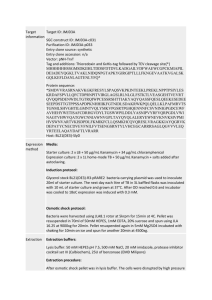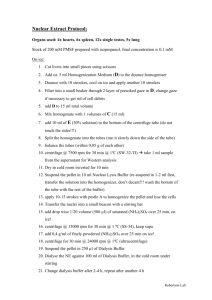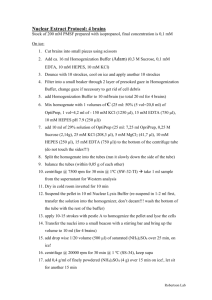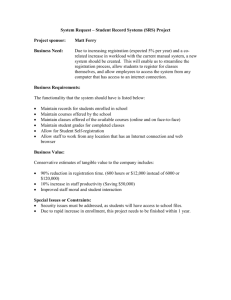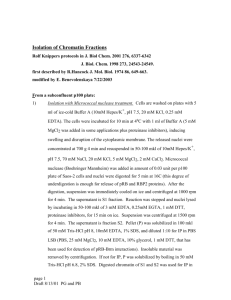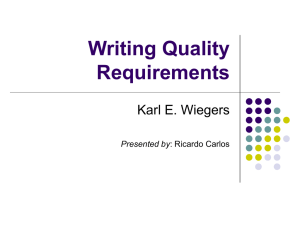Supplemental_Material
advertisement
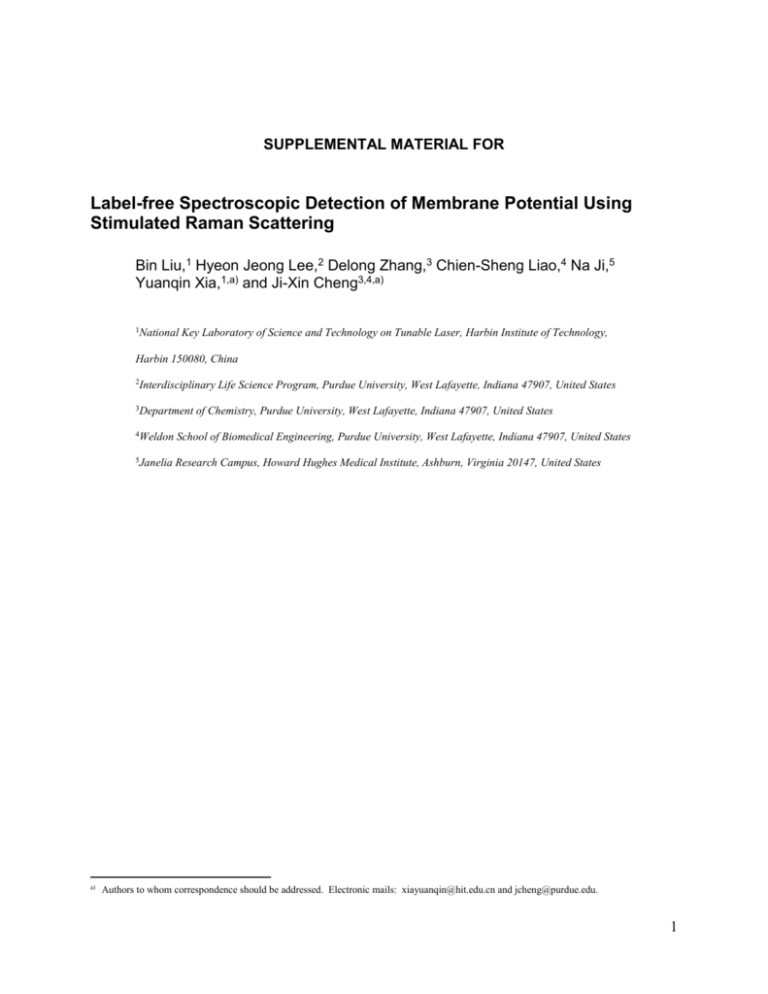
SUPPLEMENTAL MATERIAL FOR Label-free Spectroscopic Detection of Membrane Potential Using Stimulated Raman Scattering Bin Liu,1 Hyeon Jeong Lee,2 Delong Zhang,3 Chien-Sheng Liao,4 Na Ji,5 Yuanqin Xia,1,a) and Ji-Xin Cheng3,4,a) 1National Key Laboratory of Science and Technology on Tunable Laser, Harbin Institute of Technology, Harbin 150080, China 2Interdisciplinary 3Department a) Life Science Program, Purdue University, West Lafayette, Indiana 47907, United States of Chemistry, Purdue University, West Lafayette, Indiana 47907, United States 4Weldon School of Biomedical Engineering, Purdue University, West Lafayette, Indiana 47907, United States 5Janelia Research Campus, Howard Hughes Medical Institute, Ashburn, Virginia 20147, United States Authors to whom correspondence should be addressed. Electronic mails: xiayuanqin@hit.edu.cn and jcheng@purdue.edu. 1 Preparation of erythrocyte ghosts The erythrocyte ghosts were prepared according to established protocols.1,2 In brief, the blood of mouse was first diluted with the erythrocyte buffer solution1 at a ratio of 1:20. After three times’ washing, the erythrocytes were then exposed to ice-cold 5 mM phosphate buffer (pH 8.0) which caused the erythrocytes to lyse. The samples were kept close to 0°C for 2 minutes, after which the solution was centrifuged for 15 minutes at 18, 000 g and the supernatant was removed from the pellet. Thereafter the resealing buffer (50 mM NaCl, 5 mM phosphate buffer, pH 8.0) was added to allow for resealing of the membranes. The resealing process lasted 1 hour at room temperature. In order to get rid of all hemoglobins from the cells, we repeated the lysis and resealing procedures twice. When imaged by SRS microscopy, the formed erythrocyte ghost appears as a spherical vesicle. Intravesicular and extravesicular ionic compositions The 3 different transmembrane potentials shown in Fig. 4 were generated by manipulating the intravesicular and extravesicular ionic compositions. We first replaced resealing buffer with the desired inside buffer, 65 mM NaCl/75 mM KCl/10 mM Hepes, pH 7.5/0.25 mM MgCl 2, and equilibrated 16 hours at 4 ℃. Then the constituent of the outside buffer was varied to create 3 different transmembrane potentials according to ref. 3. Specifically, the outside buffer was 140 mM NaSCN, pH 7.5/0.25 mM MgCl2/10 mM Hepes for 10 mV, 65 mM NaCl/75 mM KCl/10 mM Hepes, pH 7.5/0.25 mM MgCl2 for 1 mV and 140 mM NaHepes, pH 7.5/0.25 mM MgSO4 for 10 mV. The inside and outside ionic compositions for the erythrocyte ghost shown in Fig. 3 were 65 mM NaCl/75 mM KCl/10 mM Hepes, pH 7.5/0.25 mM MgCl2 and 140 mM NaCl/10 mM Hepes, pH 7.5/0.25 mM MgCl2, respectively. All experiments shown in the manuscript were done within 2 hours after establishing transmembrane gradients. 2 SRS Spectrum analysis For SRS spectrum analysis, we first removed the background contribution from the surrounding buffer. Then the resultant SRS spectrum was normalized with the two-photon absorption signal of Rhodamine 6G. Thereafter the SRS spectrum was least-squares fitted as a sum of seven Lorentzian bands.4,5 7 I SRS ( ) i 1 2 Ai i 4 i 2 i2 , where ω is the wavenumber, Ai is the area under the ith band, Γi is the width, and Ωi is the center wavenumber of the ith band. Table SI lists the peak wavenumbers and widths for curve fitting. Corresponding assignments of Raman peaks can be found in our previous paper.5 An example of fitted curve parameters is shown in Table SII. The areas under Raman bands at 2930 cm1 (A2930) and 2850 cm1 (A2850) were used to characterize the transmembrane potential induced SRS spectral profile change. TABLE SI. Lorentzian fitting parameters. Peak center Width (Ωi, cm) (Γi, cm) 2845-2855 28.41 2856.5-2870 33.97 2875-2888 33.30 2885-2910 40.61 2930-2945 53.24 2958-2972 39.05 2980-3000 40.61 3 TABLE SII. Typical results of fitted curve parameters (peak center, width and area under the peak). The numbers in parentheses are the corresponding standard errors. Reduced Chi-Sqr: 0.01105; Adj. Rsquare: 0.94642. Peak center Width Area under the peak (a.u.) (Ωi, cm) (Γi, cm) 2850.46 (3.44) 28.41 24.45 (9.34) 2869.59 (10.39) 33.97 26.94 (15.62) 2887.48 (13.41) 33.30 23.15 (16.93) 2907.08 (16.46) 40.61 28.31 (18.95) 2931.74 (10.59) 53.24 72.94 (18.86) 2958.01 (11.00) 39.05 18.92 (13.93) 2989.90 (14.94) 40.61 8.77 (5.87) References 1 J. Guck, R. Ananthakrishnan, H. Mahmood, T. J. Moon, C. C. Cunningham, and J. Kas, Biophys. J. 81 (2), 767 (2001). 2 E. O. Potma and X. S. Xie, J. Raman Spectrosc. 34 (9), 642 (2003). 3 R. B. Mikkelsen, S. P. Verma, and D. F. H. Wallach, Proc. Natl. Acad. Sci. USA 75 (11), 5478 (1978). 4 J.-x. Cheng, A. Volkmer, L. D. Book, and X. S. Xie, J. Phys. Chem. B 106 (34), 8493 (2002). 5 S. Yue, J. M. Cárdenas-Mora, L. S. Chaboub, S. A. Lelièvre, and J.-X. Cheng, Biophys. J. 102 (5), 1215 (2012). 4
